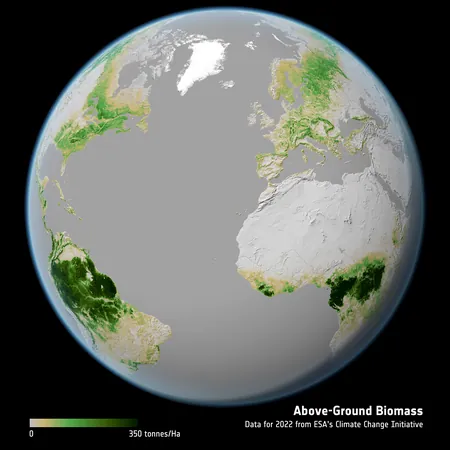
ESA Unveils Record-Breaking Dataset on Forest Biomass: A Game-Changer for Climate Science!
2025-05-05
Author: Sarah
In an exciting leap for climate research, the European Space Agency (ESA) has launched an unprecedented dataset detailing forest biomass, derived from satellite observations spanning nearly two decades! This groundbreaking initiative comes on the heels of the recent launch of the Biomass satellite on April 29, which promises to enhance our understanding of global forest carbon dynamics.
The latest dataset, a remarkable compilation developed under ESA's Climate Change Initiative, combines information from various satellite missions and will be further enriched by the Biomass satellite's own data. Covering the years 2007 to 2022, it presents a comprehensive perspective on changes in carbon-rich vegetation—particularly limbs and trunks—across the globe.
Frank Martin Seifert from ESA heralded this new release as a "pivotal moment for climate science," emphasizing its vital role in supporting global climate and carbon models, forest management strategies, and National Greenhouse Gas Reporting, in alignment with the Paris Agreement of the UN Framework Convention on Climate Change.
Forests are essential in the global carbon cycle, serving as significant carbon stores. Yet, they can release vast amounts of carbon back into the atmosphere due to deforestation and wildfires, exacerbating climate change. The newly unveiled dataset is crucial for tracking these dynamics, providing the precision required for informed climate action.
Utilizing a diverse array of Earth-observing satellites—including ESA's Envisat, the Copernicus Sentinel-1, Japan's ALOS PALSAR, and NASA's ICESat—this dataset improves the reliability of biomass estimates, especially in high-density forest regions previously underestimated.
Richard Lucas, who leads ESA's Climate Change Initiative Biomass Project, highlighted the dataset's contributions, stating it offers a far more accurate depiction of global forest biomass. However, it also carries challenges: capturing carbon-rich ecosystems with more than 400 tons of biomass per hectare remains a hurdle due to limitations in current radar technology.
Maurizio Santoro from Gamma Remote Sensing emphasized the dataset's superior quality when evaluated against independent reference data, while still identifying the need for enhanced analysis of carbon storage dynamics—something that the upcoming ESA Biomass mission aims to address.
Equipped with state-of-the-art spaceborne P-band radar technology designed to penetrate dense forest canopies, the Biomass satellite is set to revolutionize assessments of forest carbon stocks. This innovative tool is expected to significantly reduce uncertainties in tropical regions—like the Amazon and Central Africa—where measuring biomass has historically been challenging.
As Prof. Lucas optimistically adds, the forthcoming data from the Biomass mission could significantly reduce uncertainties related to the global carbon cycle, paving the way for more effective climate solutions. Stay tuned as ESA continues to unveil advancements that will transform our understanding of forest ecosystems and their crucial role in combating climate change!




 Brasil (PT)
Brasil (PT)
 Canada (EN)
Canada (EN)
 Chile (ES)
Chile (ES)
 Česko (CS)
Česko (CS)
 대한민국 (KO)
대한민국 (KO)
 España (ES)
España (ES)
 France (FR)
France (FR)
 Hong Kong (EN)
Hong Kong (EN)
 Italia (IT)
Italia (IT)
 日本 (JA)
日本 (JA)
 Magyarország (HU)
Magyarország (HU)
 Norge (NO)
Norge (NO)
 Polska (PL)
Polska (PL)
 Schweiz (DE)
Schweiz (DE)
 Singapore (EN)
Singapore (EN)
 Sverige (SV)
Sverige (SV)
 Suomi (FI)
Suomi (FI)
 Türkiye (TR)
Türkiye (TR)
 الإمارات العربية المتحدة (AR)
الإمارات العربية المتحدة (AR)